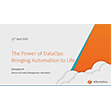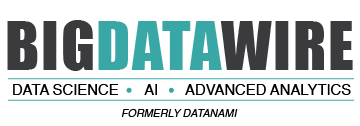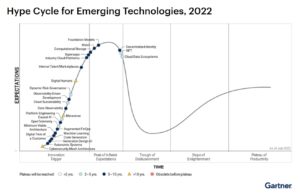
Data Observability, Metaverse Land on Gartner’s Hype Cycle for Emerging Tech

(Lightspring/Shutterstock)
The dog days of August are here, which can only mean one thing: It’s time for Gartner’s Hype Cycle for Emerging Technologies! The 2022 version includes numerous data and AI technologies among its 25 entries, including data observability and the metaverse. But which tech has the staying power to survive the hype?
Gartner produces many hype cycles–click here to read Jaime Hampton’s take on Gartner’s hype cycle for the integration platform as a service (iPaaS) market. But the hype cycle for emerging tech is unique because it distills the respected analyst group’s collective insight into more than 2,000 technologies it tracks into a set of two dozen “must-know” topics that have the potential to move the needle for early adopters over the next two to 10 years.
Gartner grouped its 2022 Hype Cycle around three themes that it sees playing outsize roles in today’s tech landscape. They include immersive experiences, AI automation, the optimizing how technologists deliver new tech.
Tech to watch in the immersive experiences category include metaverse, non-fungible tokens (NFTs), super apps and Web3, decentralized identity, digital humans, digital twin of the customer, and internal talent marketplaces. In AI automation, Gartner advises keeping an eye on tech like autonomic systems, causal AI, foundation models, generative design AI, and machine learning code generation.
Meanwhile, technologists will lean on a host of things to help them with the delivery of new digital products and services, including: computational storage, data observability, OpenTelemetry, observability driven development, cloud data ecosystems, cloud sustainability, cybersecurity mesh architecture, dynamic risk governance, industry cloud platforms, minimum viable architecture, platform engineering, and augmented FinOps.
“All technologies on this Hype Cycle are at an early stage,” Gartner Distinguished VP Analyst Gary Olliffe says in a press release, “but some are nascent and great uncertainty exists about how they will evolve. Such technologies present greater risks for deployment, but potentially greater benefits for early adopters who can assess and exploit them in line with their organization’s ability to handle unproven technologies.”
The metaverse, which refers to virtual reality and augmented reality (listed on emerging tech hype cycles of the past), is predominantly a consumer-oriented technology. However, because of its enormous potential, big tech firms are pounding their stakes into the ground now in hopes of being ready when the technology matures (still more than 10 years from now, per Gartner). The metaverse is also being spied as a potential new delivery vehicle for real-time analytic insights, and the potential around data collection is huge.
Data observability has been on the of hottest topics of the past two years, and is a topic that we’re expecting to keep making news in the second half of 2022. We also applaud Gartner including OpenTelemetry in its new hype cycle, as the technology has emerged as a standard that vendors of data and IT observability and application performance management (APM) tools can agree on.

Data observability is quickly becoming a must-have for organizations drowning in data (kurhan/Shutterstock)
Causal AI, meanwhile, is an emerging field that looks to take the AI field beyond the application of statistical probabilities and into modeling the actual cause and effect of phenomena. In the field of predicting human behavior, causal AI can help policymakers to avoid making “devastating…mistakes” wrought by the age-old error of confusing correlation with causation, researchers with the Surgo Foundation wrote in “The Case for Causal AI,” which was published two years ago in the Stanford Social Innovation Review.
Computational storage is an emerging tech that sees the addition of processors within the confines of the storage device. These computational storage devices (CSDs), such as the new SmartSSD that Samsung plans to ship later this year, can offload processing and acceleration from servers, thereby reducing the strain on CPUs and saving network bandwidth.
Gartner has also picked up on the recent activity around cloud data ecosystems, which is something we’re also tracking at Datanami. Industry giants like AWS and Snowflake have an early lead in the category, but new data marketplaces are popping up quickly, such as the one that Databricks launched less than two months ago.
Other tech included in the 2022 list, including things like observability-driven development–in which the state and behavior of system before, during, and after development is tracked–have the potential to help accelerate the development of better, more responsive, and more secure applications.
One thing that concerns us is that only three of the technologies listed on the 2021 Hype Cycle for Emerging Technologies returned in 2022. That makes it hard to gauge how Gartner is tracking the development of these emerging technologies over time (alas, we are not paying subsribers).
NFTs and Decentralized Identify, which were neck and neck in the 2021 Hype Cycle, are still tied at the hip, but they moved further off the Peak of Inflated Expectations and are headed directly toward the Trough of Disillusionment, with two to five years still before they climb out of the Slope of Enlightenment towards the holy Plateau of Productivity. Digital Humans, meanwhile, stayed about where it was in 2021: firmly planted on the climb to the Peak of Inflated Expectations following the Innovation Trigger, with a 10-plus year wait to reach the promised land.
Technologies that we wish were still included on the Hype Cycle include: quantum ML, homomorphic encryption, physics-informed AI, AI augmented design, active metadata management, and data fabric. We also wonder whatever happened to smart dust, which used to be a perennial contender in Gartner’s annual mid-summer compilation but has apparently been relegated to the dustbin of tech history.
Related Items:
Gartner Shuffles the Technology Deck with Latest ‘Hype Cycle’ Report (2021)
Gartner Gets Hyped for Emerging Tech (2020)
Gartner Sees AI Democratized in Latest ‘Hype Cycle’ (2018)
February 13, 2025
- SingleStore Unveils No-Code Solution Designed to Cut Data Migration from Days to Hours
- Databricks Announces Launch of SAP Databricks
- SAP Debuts Business Data Cloud with Databricks to Turbocharge Business AI
- Data Science Salon Kickstarts 2025 with DSS ATX Conference, Featuring AI Startup Showcase
- Hydrolix Achieves Amazon CloudFront Ready Designation
- Astronomer Launches Astro Observe to Unify Data Observability and Orchestration
- EU Launches InvestAI Initiative to Build AI Gigafactories Across Europe
- HPE Announces Shipment of Its First NVIDIA Grace Blackwell System
- IDC Celebrates 60 Years of Tech Intelligence at Directions 2025
- Lucidity Gains $21M to Scale AI-Driven Cloud Storage Optimization
- Glean Launches Open Security and Governance Partner Program for Enterprise AI
February 12, 2025
- Cerebras Powers Perplexity Sonar with Industry’s Fastest AI Inference
- Cloudera Welcomes Tom Brady as Keynote Speaker at ELEVATE26
- Confluent Expands Databricks Partnership for Real-Time AI Data Integration
- Esri Developer & Technology Summit Features Expanded Program to Reflect Growth of Geospatial Development
- Airbyte Introduces Capacity-Based Pricing for Predictable Data Movement Costs
- Glean Unveils AI Agent Platform for Enterprise-Wide Automation
- Ataccama Lineage Launches to Deliver End-to-End Visibility into Data Flows
- XENON Systems and Netris Partner to Deliver Multi-Tenant GPU Cloud Networking Solutions
- HPE Unveils ProLiant Compute Gen12 Servers with AI-Driven Management
- OpenTelemetry Is Too Complicated, VictoriaMetrics Says
- The Top 2025 GenAI Predictions, Part 2
- PayPal Feeds the DL Beast with Huge Vault of Fraud Data
- What Are Reasoning Models and Why You Should Care
- Three Ways Data Products Empower Internal Users
- Slicing and Dicing the Data Governance Market
- Keeping Data Private and Secure with Agentic AI
- Memgraph Bolsters AI Development with GraphRAG Support
- Why Data Lakehouses Are Poised for Major Growth in 2025
- Three Data Challenges Leaders Need To Overcome to Successfully Implement AI
- More Features…
- Meet MATA, an AI Research Assistant for Scientific Data
- AI Agent Claims 80% Reduction in Time to Complete Data Tasks
- DataRobot Expands AI Capabilities with Agnostiq Acquisition
- Collibra Bolsters Position in Fast-Moving AI Governance Field
- Bloomberg Survey Reveals Data Challenges for Investment Research
- Observo AI Raises $15M for Agentic AI-Powered Data Pipelines
- Anaconda’s Commercial Fee Is Paying Off, CEO Says
- Microsoft Open Sources Code Behind PostgreSQL-Based MongoDB Clone
- Dataiku Report Predicts Key AI Trends for 2025
- Mathematica Helps Crack Zodiac Killer’s Code
- More News In Brief…
- Informatica Reveals Surge in GenAI Investments as Nearly All Data Leaders Race Ahead
- Gartner Predicts 40% of Generative AI Solutions Will Be Multimodal By 2027
- PEAK:AIO Powers AI Data for University of Strathclyde’s MediForge Hub
- DataRobot Acquires Agnostiq to Accelerate Agentic AI Application Development
- Reltio Is Recognized as Representative Vendor in 2024 Gartner Market Guide for Master Data Management Solutions
- Seagate Unveils IronWolf Pro 24TB Hard Drive for SMBs and Enterprises
- TigerGraph Launches Savanna Cloud Platform to Scale Graph Analytics for AI
- EY and Microsoft Unveil AI Skills Passport to Bridge Workforce AI Training Gap
- Alluxio Enhances Enterprise AI with Version 3.5 for Faster Model Training
- DeepSeek-R1 models now available on AWS
- More This Just In…




























